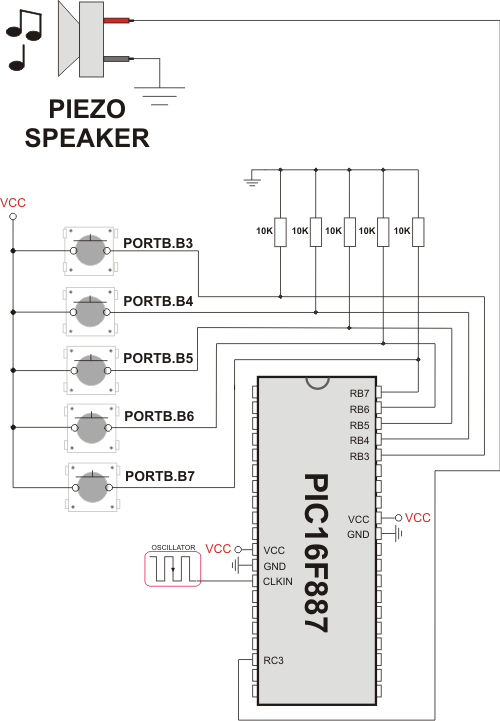Sound Library
The mikroPascal PRO for PIC provides a Sound Library to supply users with routines necessary for sound signalization in their applications. Sound generation needs additional hardware, such as piezo-speaker (example of piezo-speaker interface is given on the schematic at the bottom of this page).
Library Routines
Sound_Init
| Prototype |
procedure Sound_Init(var snd_port : byte; snd_pin : byte); |
|---|---|
| Returns |
Nothing. |
| Description |
Configures the appropriate MCU pin for sound generation. Parameters :
|
| Requires |
Nothing. |
| Example |
Sound_Init(PORTC, 3); // Initialize sound at RC3 |
Sound_Play
| Prototype |
procedure Sound_Play(freq_in_hz, duration_ms : word); |
|---|---|
| Returns |
Nothing. |
| Description |
Generates the square wave signal on the appropriate pin. Parameters :
 Note :
Frequency range is limited by Delay_Cyc parameter. Maximum frequency that can be produced by this function is Note :
Frequency range is limited by Delay_Cyc parameter. Maximum frequency that can be produced by this function is Freq_max = Fosc/(80*3). Minimum frequency is Freq_min = Fosc/(80*255). Generated frequency may differ from the freq_in_hz parameter due to integer arithmetics.
|
| Requires |
In order to hear the sound, you need a piezo speaker (or other hardware) on designated port. Also, you must call Sound_Init to prepare hardware for output before using this function. |
| Example |
// Play sound of 1KHz in duration of 100ms Sound_Play(1000, 100); |
Library Example
The example is a simple demonstration of how to use the Sound Library for playing tones on a piezo speaker.
program Sound;
procedure Tone1();
begin
Sound_Play(659, 250); // Frequency = 659Hz, duration = 250ms
end;
procedure Tone2();
begin
Sound_Play(698, 250); // Frequency = 698Hz, duration = 250ms
end;
procedure Tone3();
begin
Sound_Play(784, 250); // Frequency = 784Hz, duration = 250ms
end;
procedure Melody(); // Plays the melody "Yellow house"
begin
Tone1(); Tone2(); Tone3(); Tone3();
Tone1(); Tone2(); Tone3(); Tone3();
Tone1(); Tone2(); Tone3();
Tone1(); Tone2(); Tone3(); Tone3();
Tone1(); Tone2(); Tone3();
Tone3(); Tone3(); Tone2(); Tone2(); Tone1();
end;
procedure ToneA(); // Tones used in Melody2 function
begin
Sound_Play( 880, 50);
end;
procedure ToneC();
begin
Sound_Play(1046, 50);
end;
procedure ToneE();
begin
Sound_Play(1318, 50);
end;
procedure Melody2(); // Plays Melody2
var counter : byte;
begin
for counter := 9 downto 1 do
begin
ToneA();
ToneC();
ToneE();
end;
end;
begin
ANSEL := 0; // Configure AN pins as digital I/O
ANSELH := 0;
C1ON_bit := 0; // Disable comparators
C2ON_bit := 0;
TRISB := 0xF8; // Configure RB7..RB3 as input
Sound_Init(PORTC, 3);
Sound_Play(880, 1000);
while TRUE do // endless loop
begin
if (Button(PORTB,7,1,1)) then // If PORTB.7 is pressed play Tone3
begin
Tone1();
while (RB7_bit <> 0) do nop; // Wait for button to be released
end;
if (Button(PORTB,6,1,1)) then // If PORTB.6 is pressed play Tone2
begin
Tone2();
while (RB6_bit <> 0) do nop; // Wait for button to be released
end;
if (Button(PORTB,5,1,1)) then // If PORTB.5 is pressed play Tone1
begin
Tone3();
while (RB5_bit <> 0) do nop; // Wait for button to be released
end;
if (Button(PORTB,4,1,1)) then // If PORTB.4 is pressed play Melody2
begin
Melody2();
while (RB4_bit <> 0) do nop; // Wait for button to be released
end;
if (Button(PORTB,3,1,1)) then // If PORTB.3 is pressed play Melody
begin
Melody();
while (RB3_bit <> 0) do nop; // Wait for button to be released
end;
end;
end.
HW Connection

Example of Sound Library connection
What do you think about this topic ? Send us feedback!




